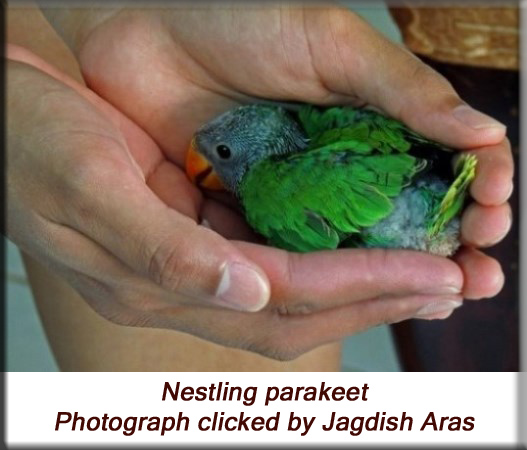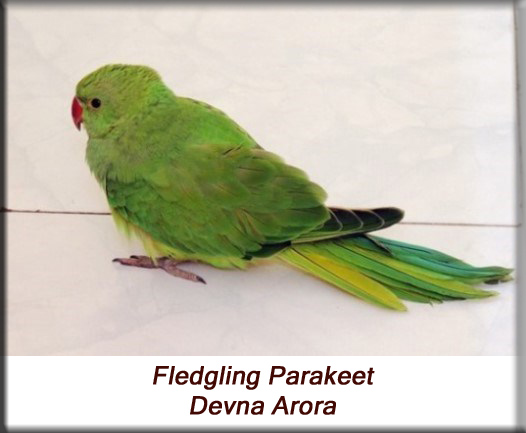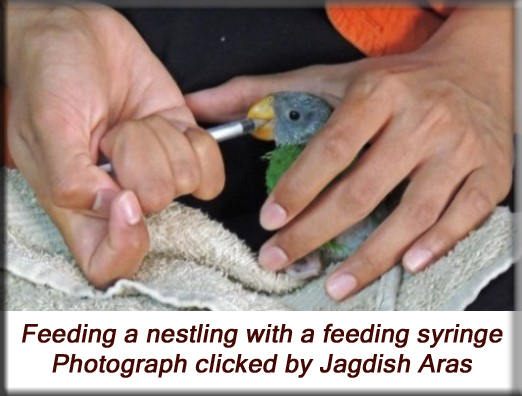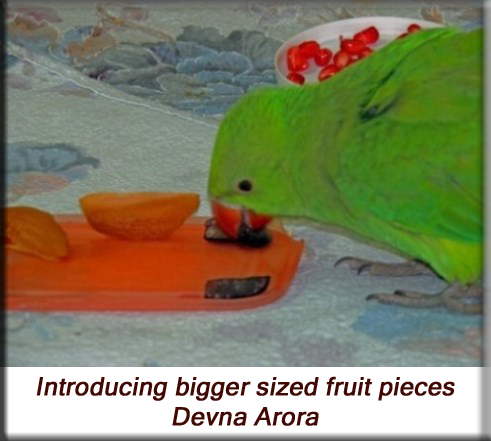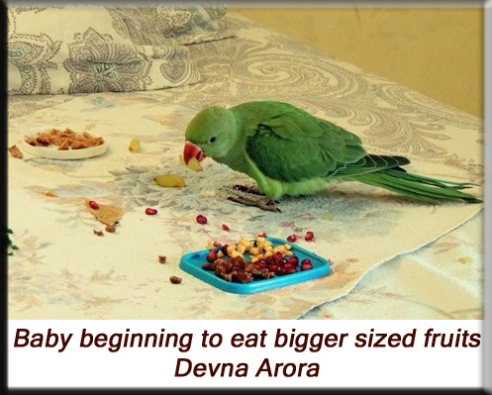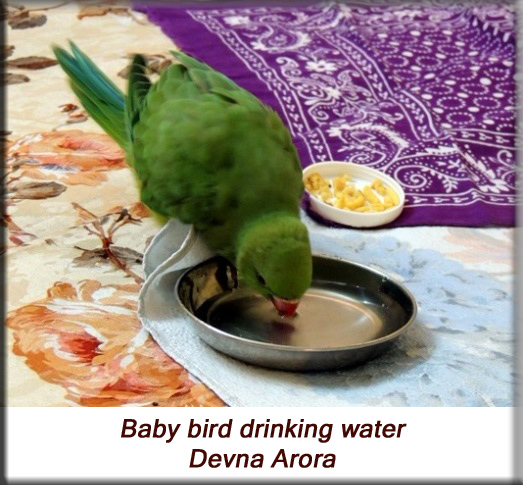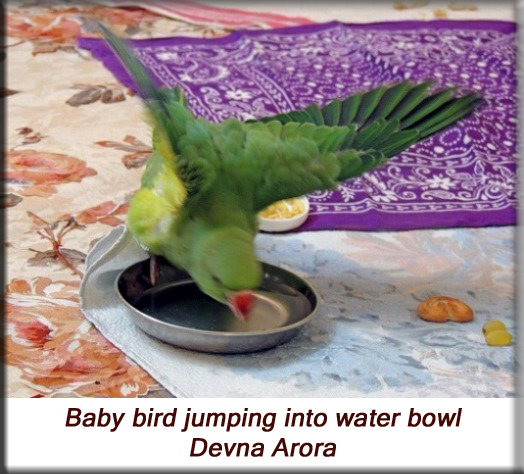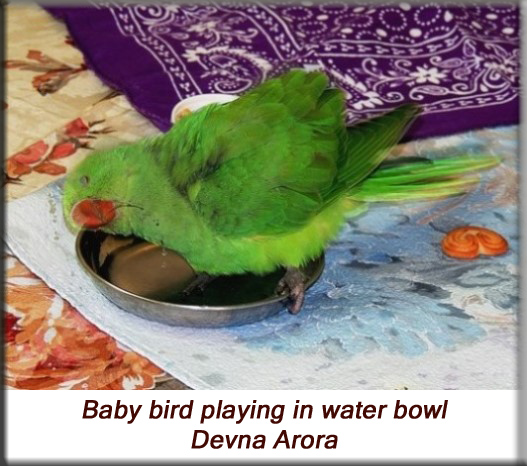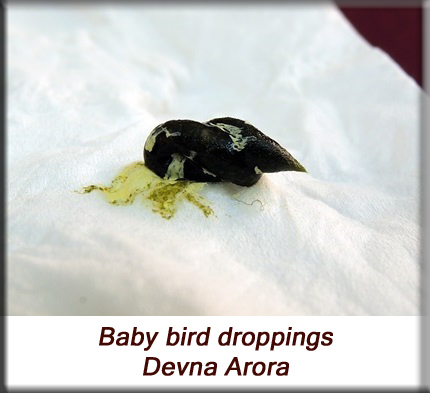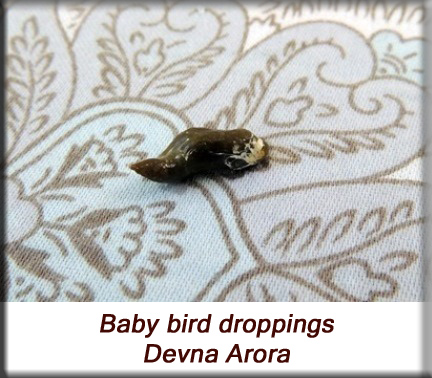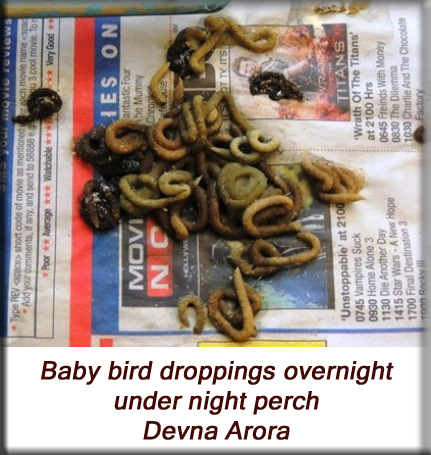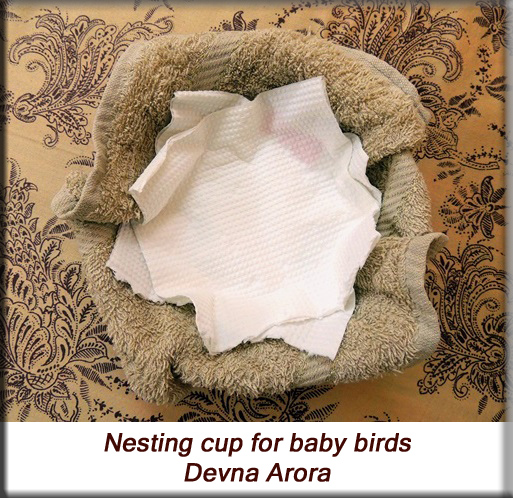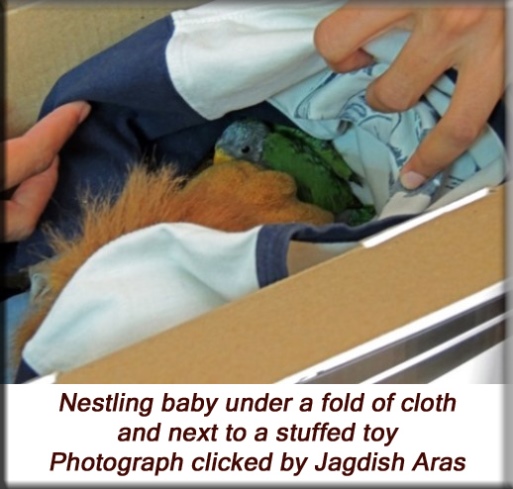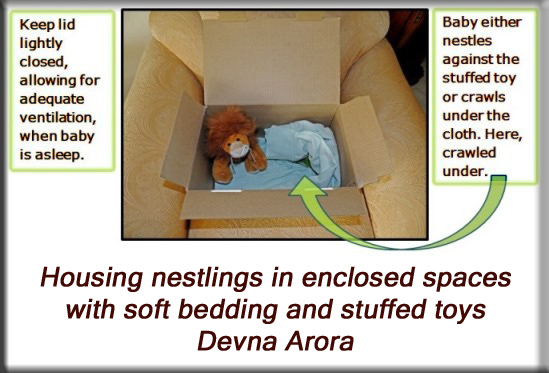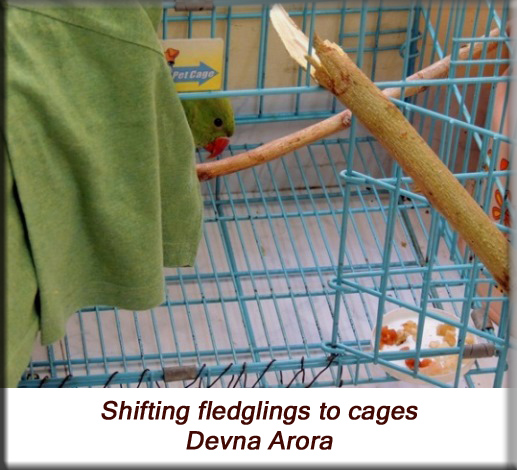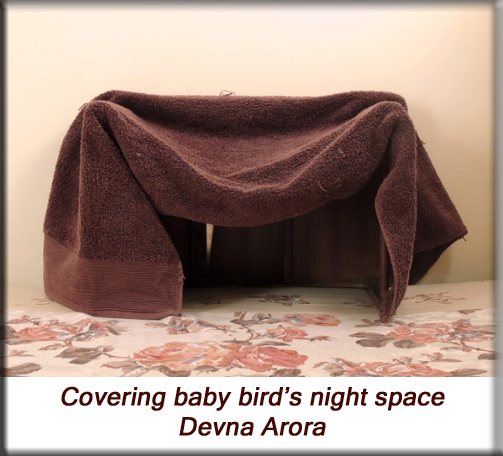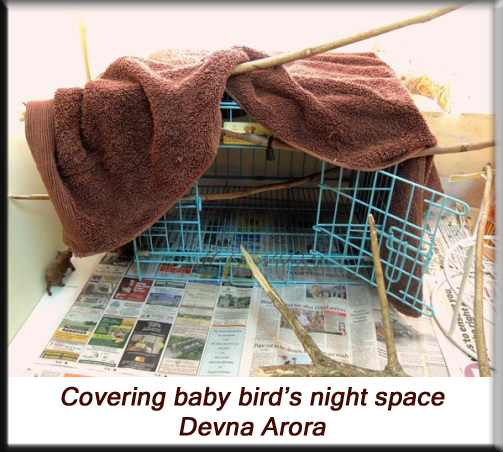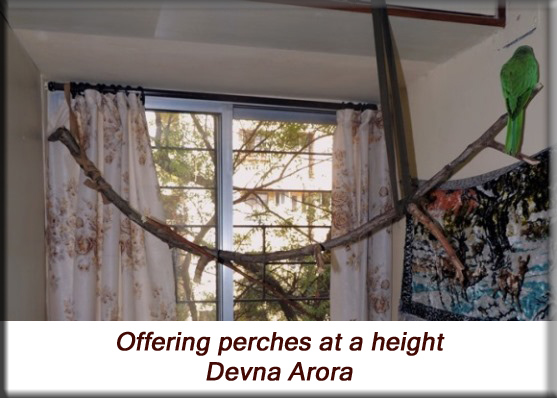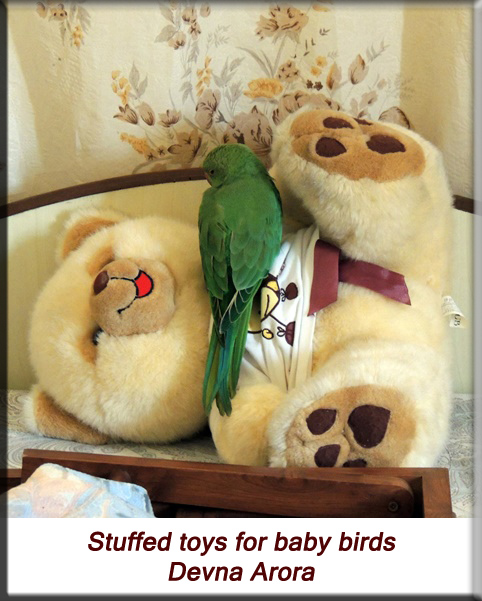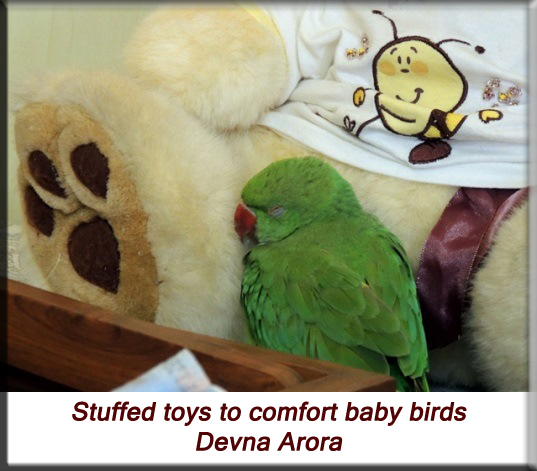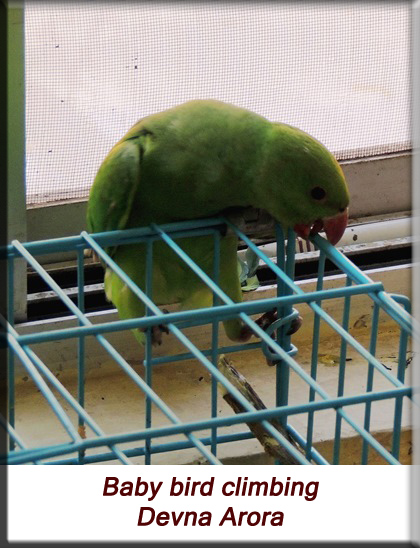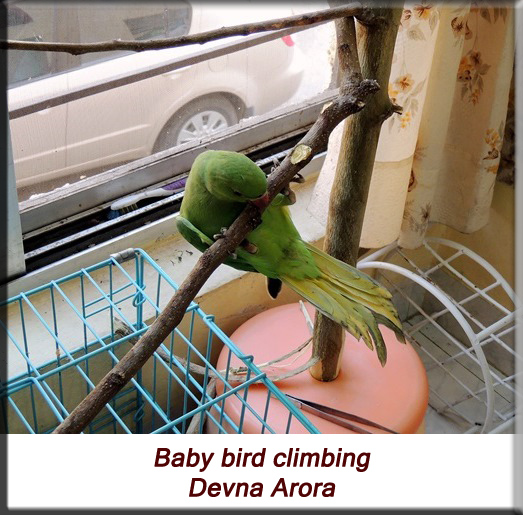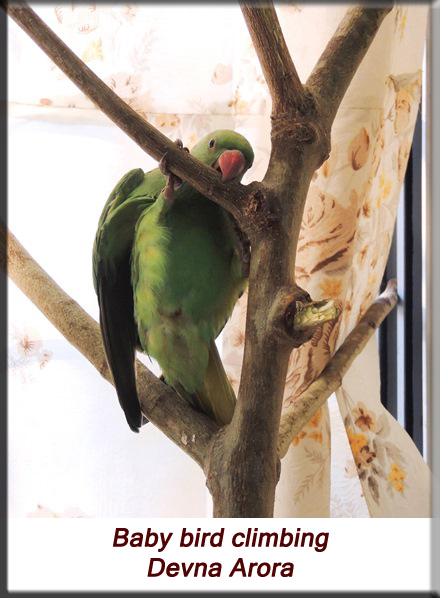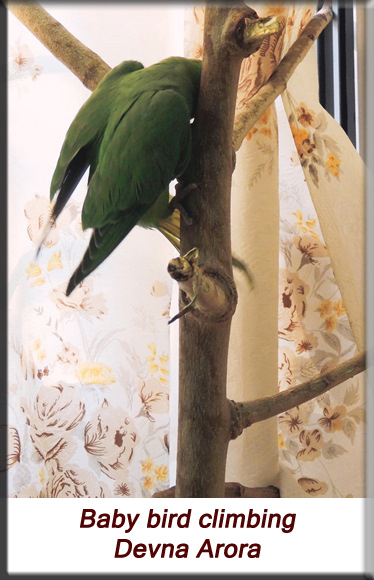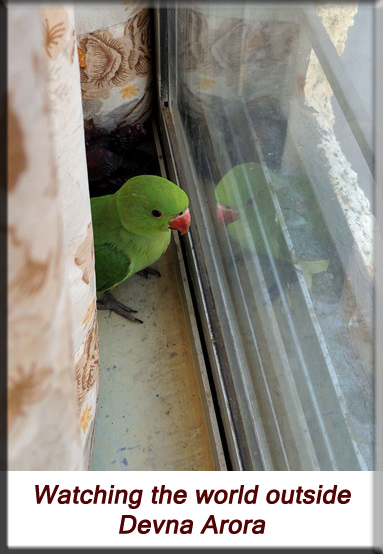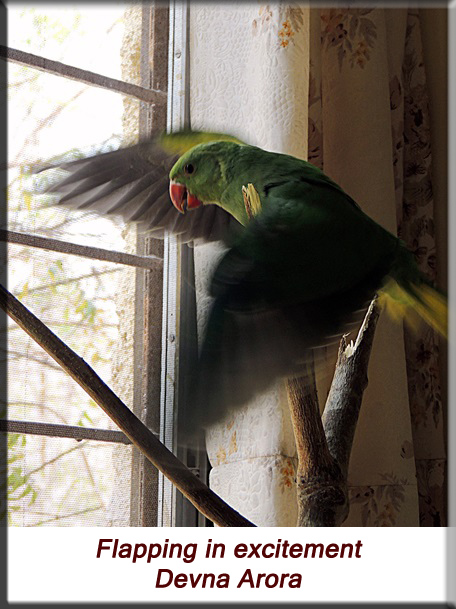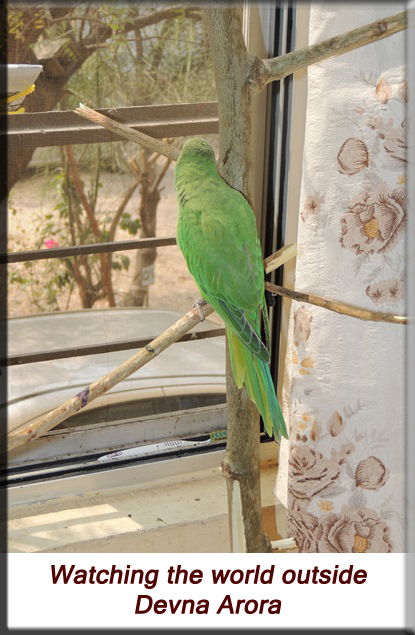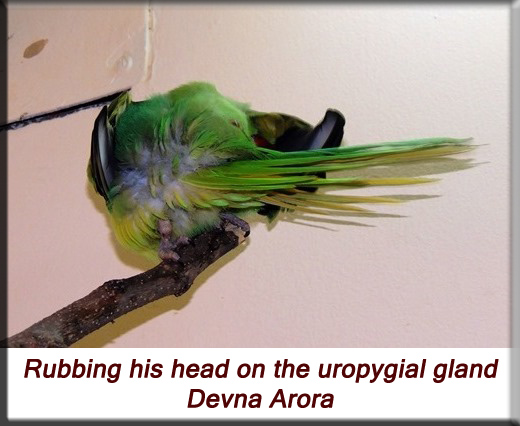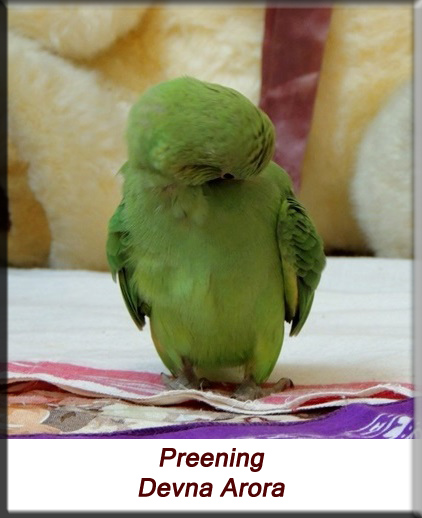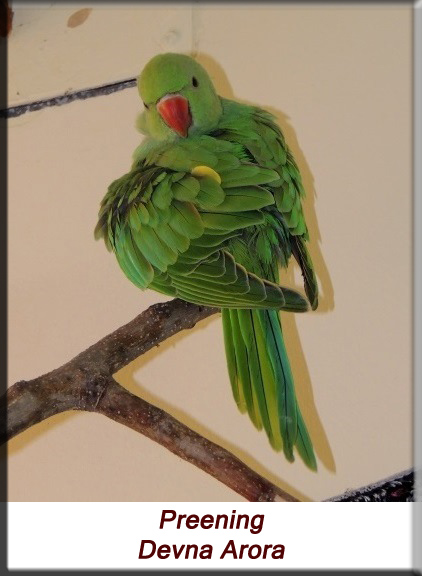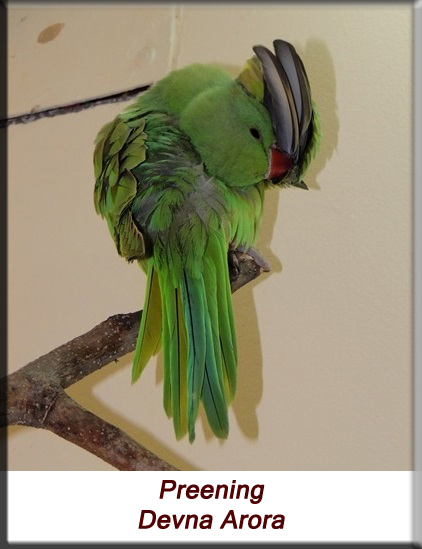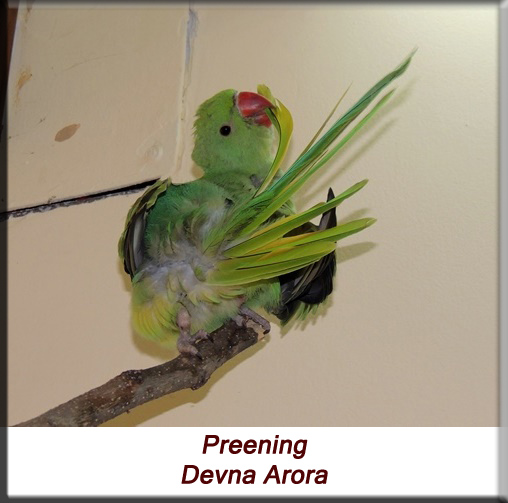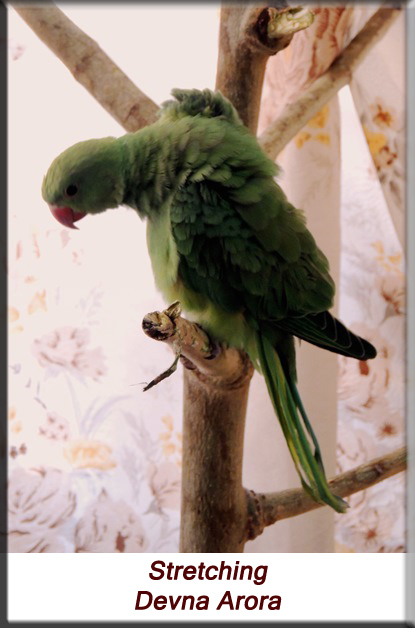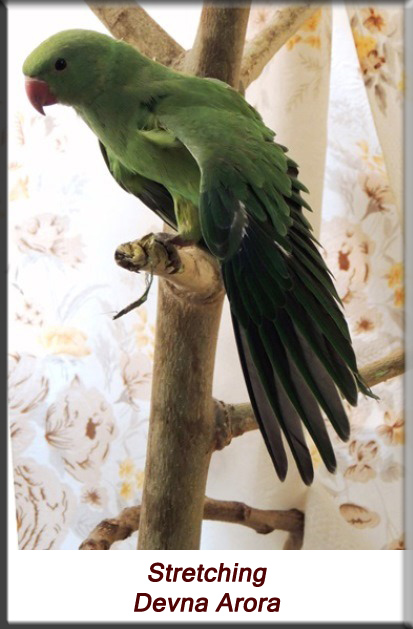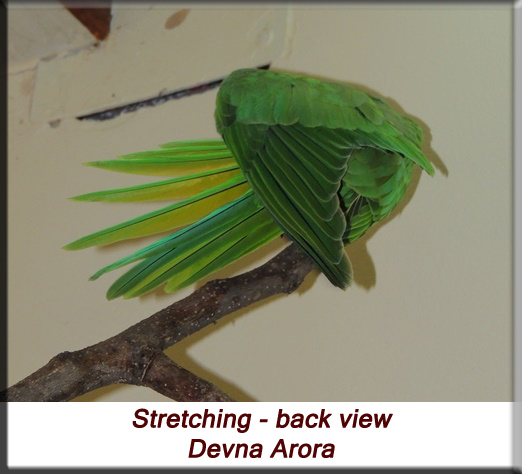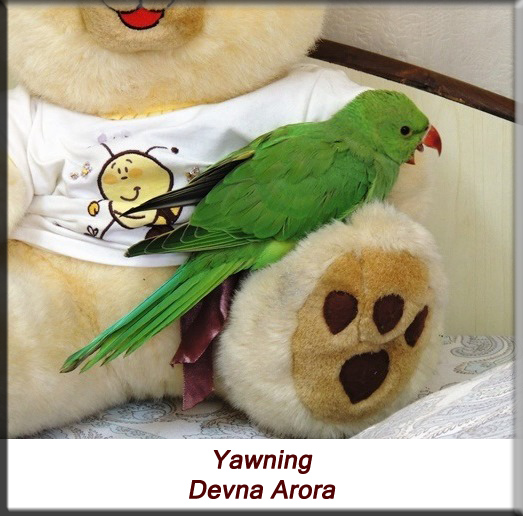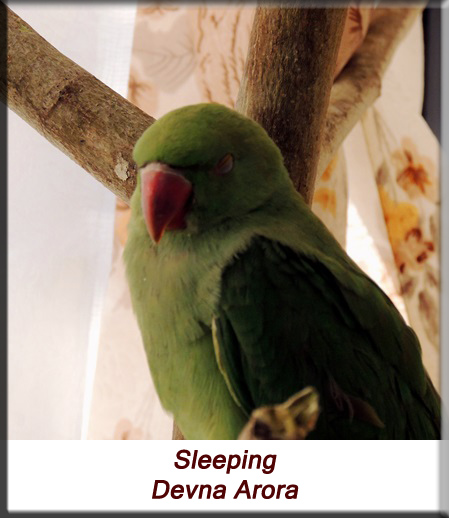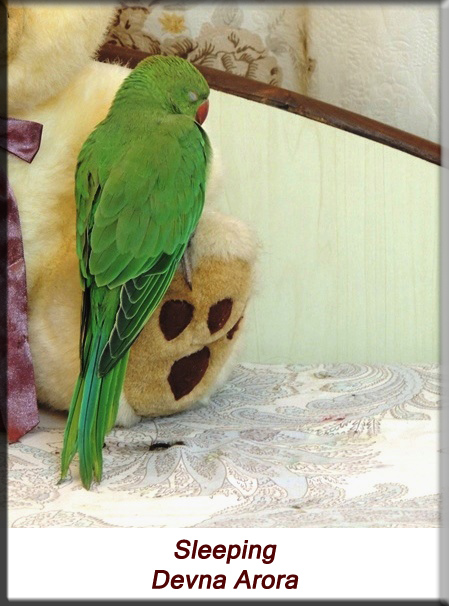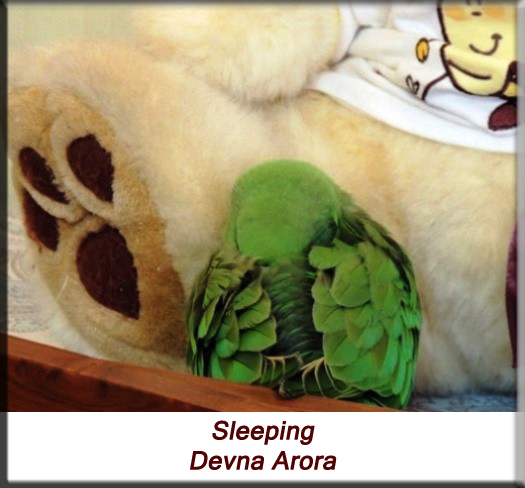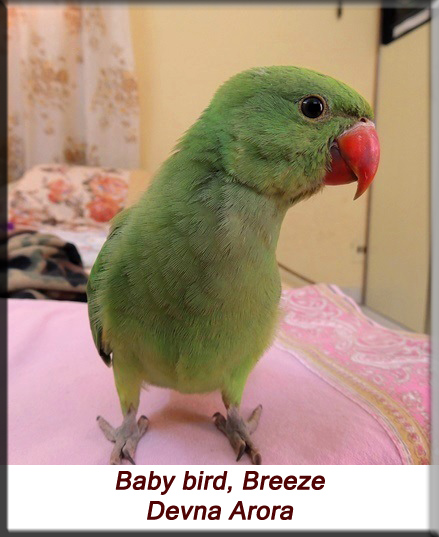A photographic guide to baby parakeet hand-raising, care and behaviour
Devna Arora
Hand-feeding baby parakeets
New born babies and younger nestlings are fed formula with a syringe. The formula must always be fresh and warm and fed with sterile syringes.
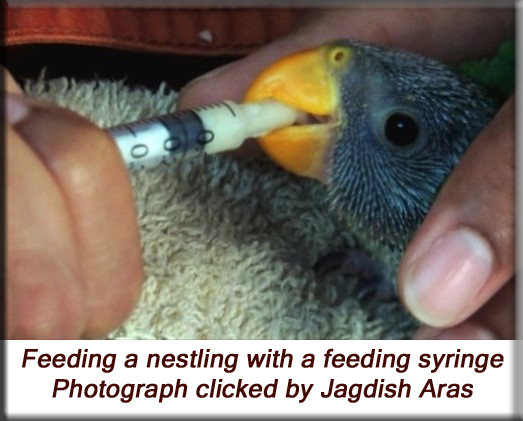
Older nestlings and fledglings must be fed using a pair of blunt-tipped forceps. You must ensure that their food is mashed and very soft when shifting the chicks from formula to feeding with a forceps.
If comfortable, you may even use a pair of chopsticks as they serve the same purpose. Refrain from letting the feeder touch the beak or tongue of the baby. Your touch must be light, only gently dropping food in the baby’s mouth.
It is easy as easy to feed older babies by hand but you must refrain from doing so to prevent the chicks from building a positive and dependent association with the human hands.
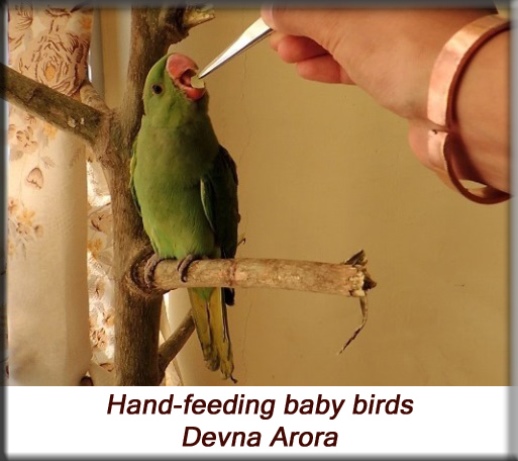
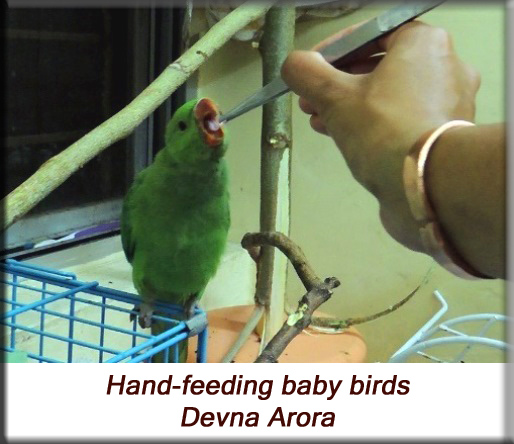
Feeding by themselves
Baby parakeets will attempt to feed themselves at about the time they fledge. Fruits, skinned and chopped into small pieces, are great to start them off. Leave a small plate of chopped fruit in front of the young bird and lift pieces of food from it and feed them. They immediately get the idea. Encourage eating by placing the fruit plate in front of them when they are hungry before attempting to feed them. The young ones will be too impatient to wait for you.
Do note that baby birds attempting to feed by themselves may not necessary get a tummy-full by themselves so continue to feed them until they are consuming adequate quantities by themselves.
Seeds, nuts, grains and bigger pieces of fruits must be introduced subsequently, giving the bird a new challenge and something new to explore each time. Once the birds are a little older and their balance improves, they will attempt to hold pieces of food in one foot and nibble at it.
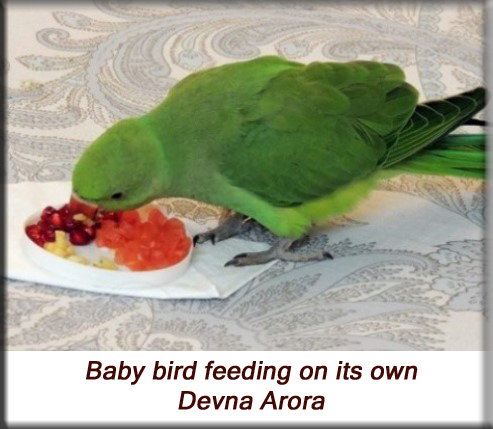
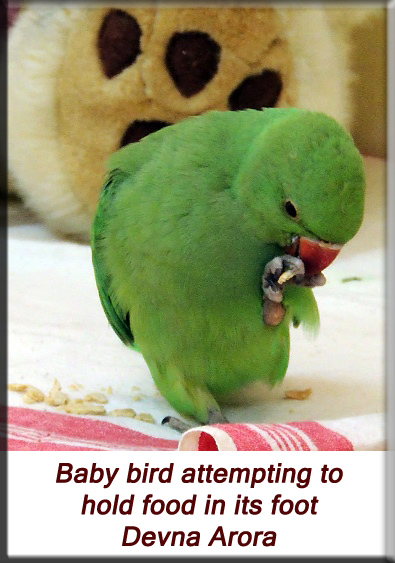
Empty and full crop
Baby birds require smaller and frequent feeds as it matches their feeding patterns in nature. Some birds though may prefer a big feed at certain times [eating a “crop-full” so to say] and then only ask for food once their crop is empty.
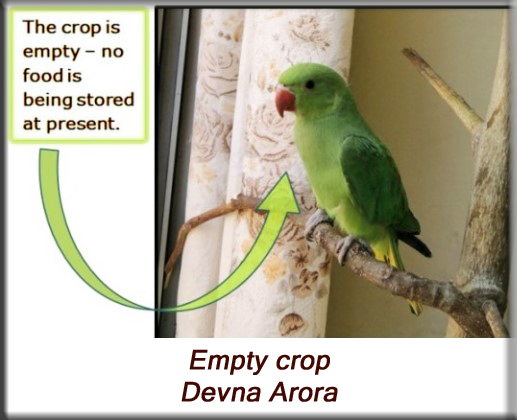
This lil’ boy, for example, would nibble on his food all through the day and then quite literally have a crop-full before going to bed. If you are unable to feed them frequently and prefer to keep them on 4-6 feeds a day, you will notice that their crop fills up after feeds and the babies start begging for their next meal once it empties.
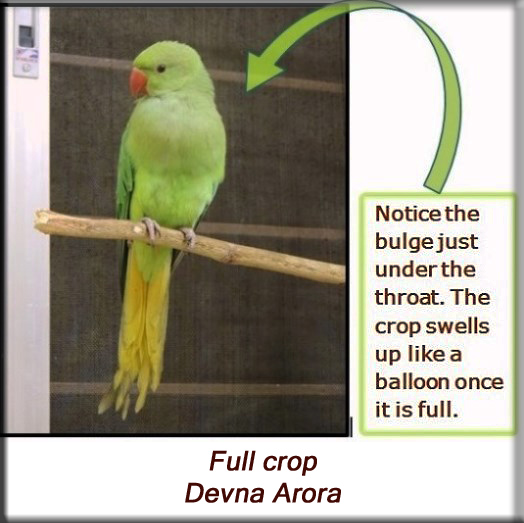
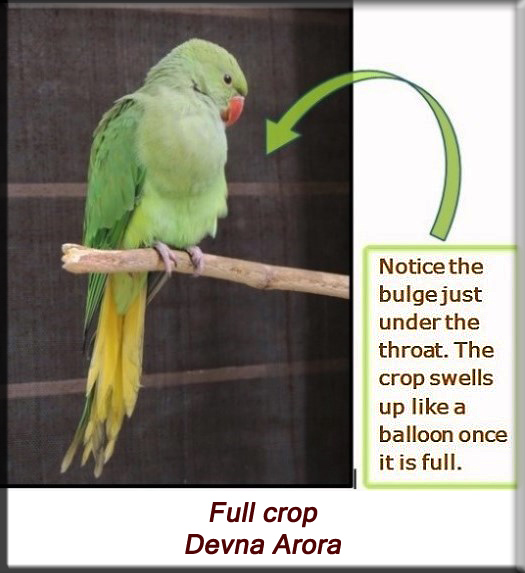
Water
Although baby birds get adequate water from their food, they will start drinking some water by fledging age. It is good practice to keep a shallow bowl of fresh water for them every day. The water must be changed if they walk or jump into their water bowls as they frequently will.
Baby bird droppings
Baby bird poop is sort of capsulate in form. This makes it easier for the parent birds to lift the poop and throw it out of the nest once it dries. Poop may vary in colour and structure depending upon the diet given.
Housing
New-borns may simply be kept in small nesting cups (like the one below) and placed in a bigger box or incubator. They require external heat for most of the day. Their skin is extremely tender and their bedding must always be soft and clean. Feathered nestlings maybe shifted to boxes with stuffed toys.
The chicks must never be placed on cloth towels directly as their claws/nails tend to get caught in the cloth loops causing them extreme discomfort and ensuing a frantic struggle to free the legs. Lining the nesting cups with paper towels not only ensures that the chicks are on a softer surface but also makes it easier to replace soiled bedding.
Fledglings may be shifted to cages or offered low perches for at least part of the day. Their legs will not be strong enough to hold on for long durations and they must not be forced to spend long hours on perches. Instead, let them decide to move wherever they feel most comfortable.
N.B. Birds under rehab must never be confined to cages – they must be free to move at will, and restricted only to larger enclosures or aviaries.
The young birds must have access to a dark, quiet and covered space at night. This may be a cage covered with a cloth, a nest box, a cardboard box, big earthen pot or any such similar comfortable structure that the bird feels secure in. This nesting space must be at a height for older birds. While older birds may prefer to sleep in the open, the bird’s preference will often depend upon weather conditions – open spaces in the pleasant summer nights and enclosed spaces during cooler winters.
Stuffed toys for orphans
Baby animals, by nature, are either always huddled against their siblings or they cling to their parents. This need may have developed as a need for warmth (heat and thermoregulation) but close proximity to their ‘families’ often signifies comfort and safety for young animals.
Orphaned babies often find great comfort in stuffed toys and cling to them closely. This has two advantages for rehabbers: it not only helps the baby feel secure and comfortable but also weakens the dependency and bonding with the caretaker – often a helpful strategy in rehab. This seems to be particularly helpful when hand-raising lone youngsters as grouped babies naturally turn towards their siblings and other conspecifics for companionship and comfort.
Climbing
As soon as their legs get stronger, the young birds will want to climb everywhere and explore. Psittacines are quite unique in their ability to use their beak as an additional limb – they will hold on to things with their beak and climb about as much as they can. Encourage this by providing closely spaced branches and perches for the young birds. Perches must always be of natural wood, i.e. tree branches, as artificial perches may be uncomfortable and cause foot problems, infections and diseases.
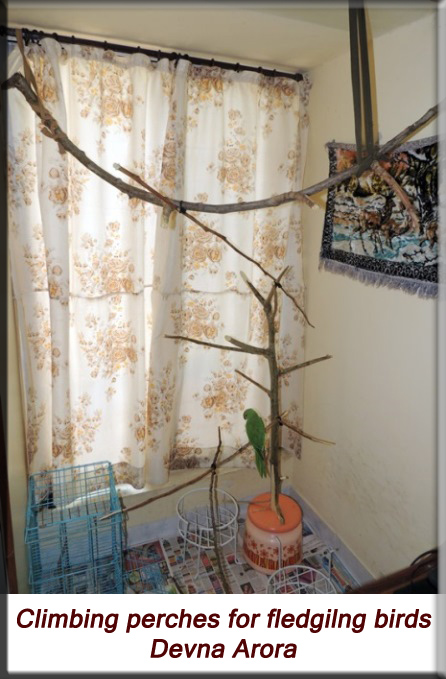
Watching the world outside
By fledging age, the young birds will be very curious about the world outside. They will spend most mornings and evenings by the windows and curiously watch all movements and listen to all sounds outside.
Parakeets are especially communicative birds and the young ones will respond to all parakeet calls. They will often communicate and interact with wild parakeets, with even an exchange of food not being unheard of. This lil’ boy had a habit of announcing his arrival at the window every single time, just in case somebody responded :o)
Introducing water baths
Baths are a great way for birds to keep themselves clean. Parakeets are naturally attracted to water and thoroughly enjoy their baths. Baby birds though will have to be introduced to baths. Being naturally curious they will readily explore novel things in their vicinity. Simply putting out a shallow bowl of water and making some splashing sounds in the bowl will attract the birds to the bath.
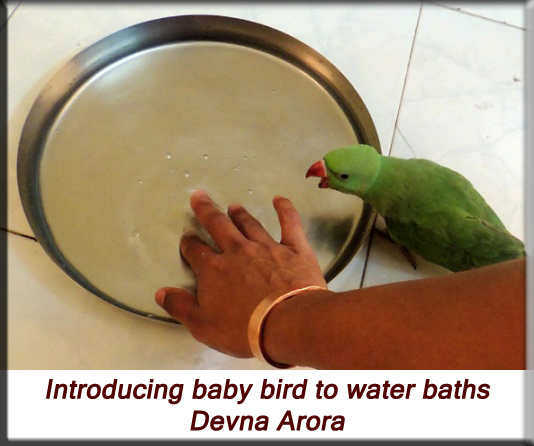
Baby birds will naturally follow your hand movements and approach the water. They may first attempt to drink the water (which they will not like initially, esp. since drinking reflex is not natural to baby birds). If unsure or confused, the young birds may even dance around the water bowl and flutter their wings in excitement as if they were in the water themselves. They will soon take a plunge and enjoy a bath.
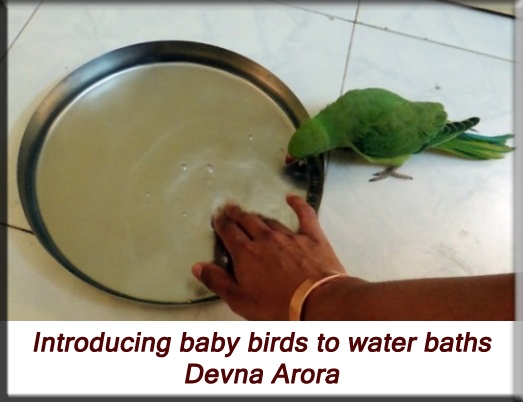
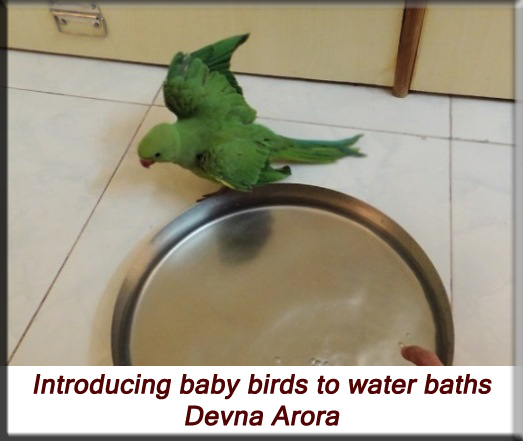
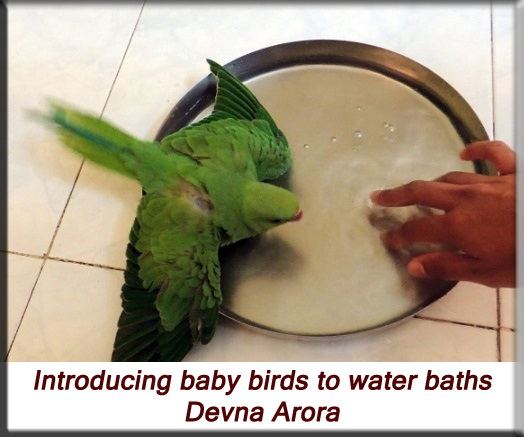
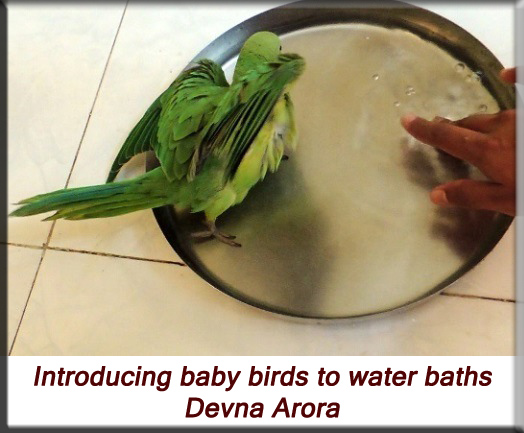
Never force the birds to experience water. Allow them to explore it when they are ready. Just knowing that you are close by and playing in (or rather with) the water yourself is often adequate to encourage the birds.
Playing in water
Once the birds enjoy their initial experiences with water, they return readily for baths. Bath water must always be lukewarm and never cold. It is good practice to offer the birds a bath in the afternoons every day. Although infrequent baths are advisable during the winters and colder spells of weather.
Some birds also enjoy mist baths/sprays just as much as their water baths. They readily lift their wings so that they may be sprayed under the wings and thoroughly enjoy the process.
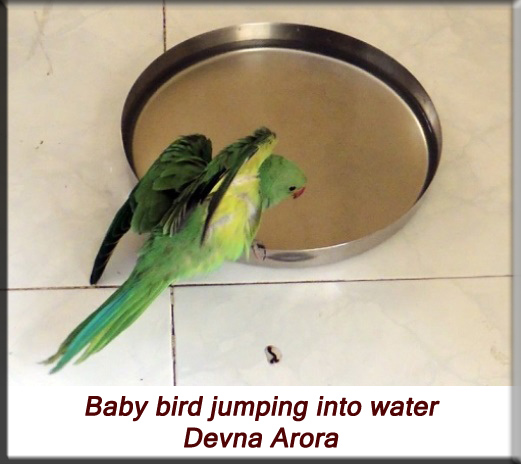
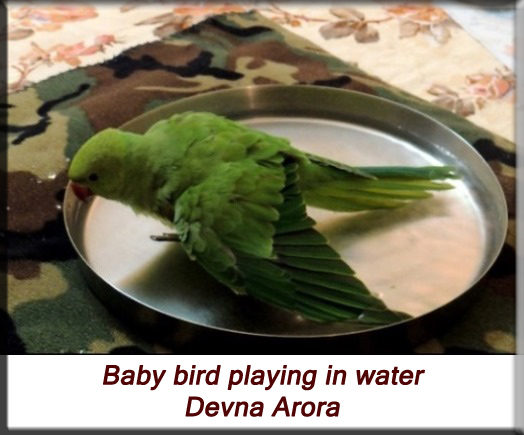
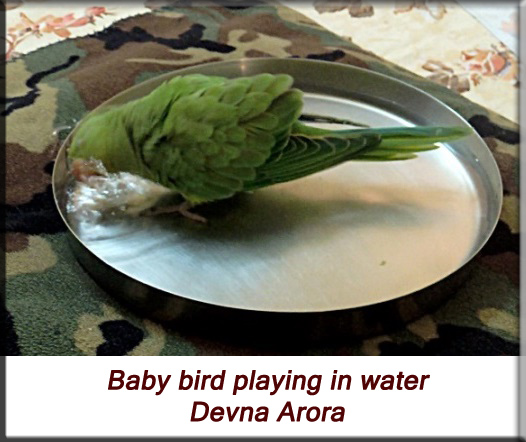
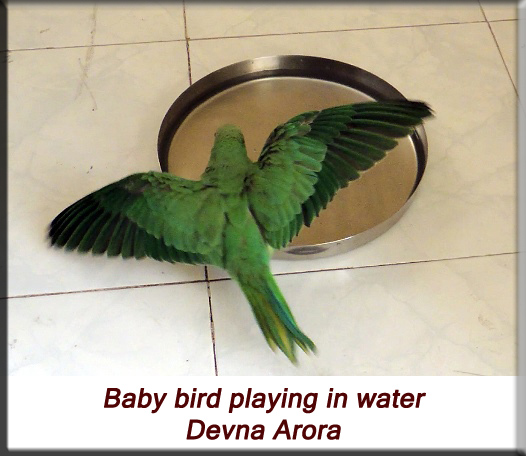
Preening
Birds are heavily dependent upon their feathers and need to keep them in prime condition. Preening is not only crucial to remove parasites but also to keep their feathers clean and well-combed. Preening also ensure that the oils from the uropygial or preen glands is well spread over the feather, forming a protective layer over the feather and keeping them in good condition.
Baby birds start preening by the time the feathers erupt but may not be able to preen effectively. They may be wiped down with a warm moist cloth to ensure they remain clean and no food or droppings stick to them.
Cleaning beak after feeding
Baby birds are messy eaters and are likely to get food all over even when being hand-fed. While older birds will meticulously clean their beaks, younger ones must be wiped clean. This is essential as baby birds with food residue are extremely vulnerable to ant attacks.
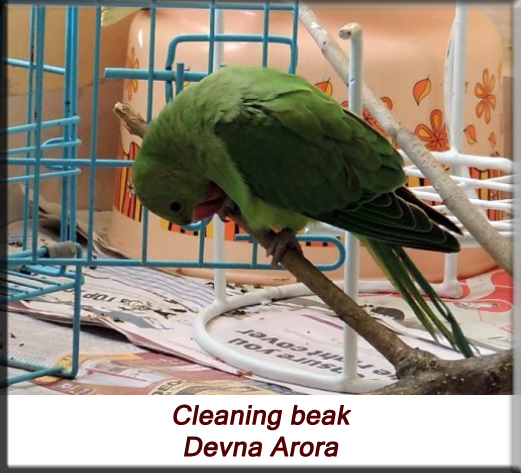
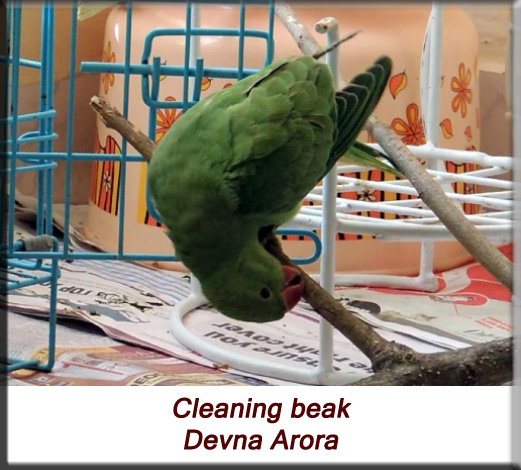
Cleaning foot
Birds naturally clean their feet a couple of times a day as a process of grooming. If a bird is excessively fiddling with the feet or grooming (unusually) frequently, it is a sign of discomfort. In all likelihood, the bird has been sitting on an uncomfortable perch which has resulted in the discomfort. Also remember to keep an eye for splinters if you notice any perches with frayed edges; and replace unsuitable perches promptly.
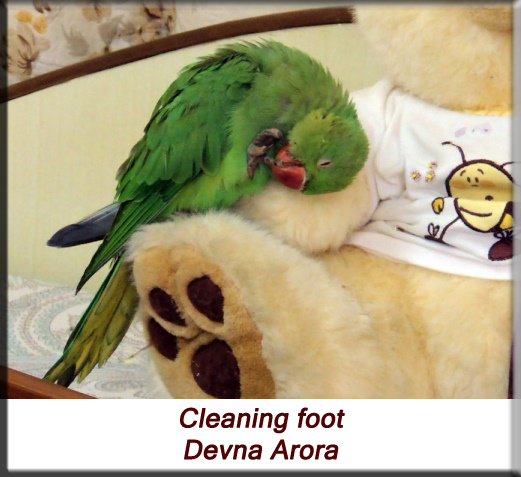
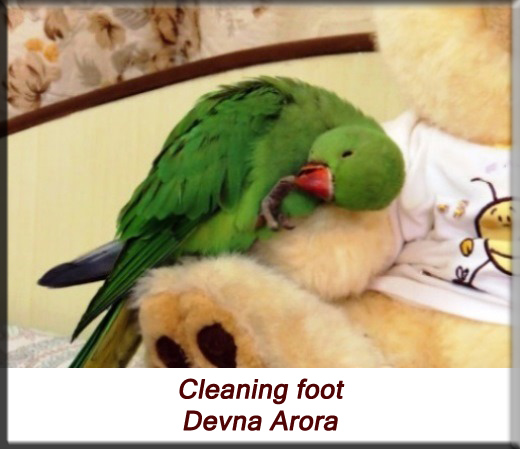
Yawning and stretching
These are simply some cute pics…
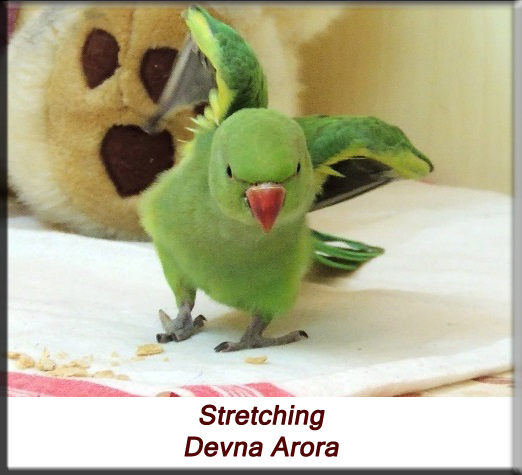
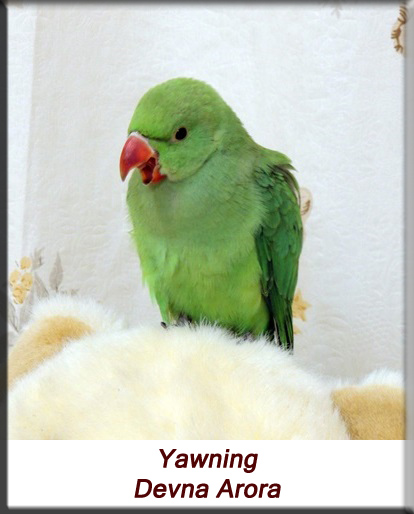
Sleeping
Animals are most vulnerable when they are asleep. It is thus a natural tendency for any animal to seek out enclosed spaces that offer them some privacy. Although baby birds will accept perches, they may prefer to seek out their own spaces, much like this baby bird who found my teddy and refuses to sleep anywhere else but on the teddy during the day.
Please note: This is simply a photographic account to help you visualize the hand-raising process better. Please refer to our protocol on the rehab of ring-neck parakeets for detailed guidelines on infant care, feeding and rehabilitation. The protocol is available on my website:
http://rehabbersden.org/Rehabilitation%20of%20baby%20Ringneck%
20parakeets.pdf
Acknowledgements
I thank my superstar, baby bird Breeze, for putting up with my intrusive camera and giving a most awesome collection of videos and photographs. It has been endearing to watch you grow and explore your new world… you have taught me so much more about baby birds like yourself!
You are now just a few steps away from freedom and I eagerly look forward to your integration with the wild parakeets that you so longingly watch and call out to. Bless you! Soar the skies!!
A big thank you to small baby bird, Kaito, for those endearing baby pics. I can’t wait for you to grow into a big and strong bird like Breeze and soar the skies together.
Thank you, Jagdish mama for coming over and taking photographs of the little baby bird.
Corina, thank you so much for your appreciation of this photographic draft and for your constant support and encouragement and help with the babies and the protocols.
Photographic guide published in 2013

